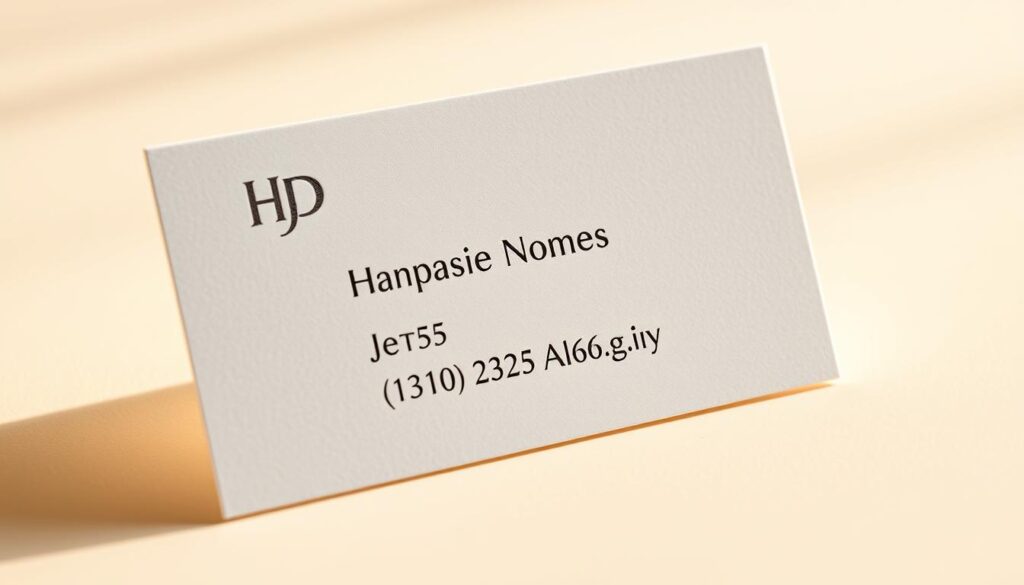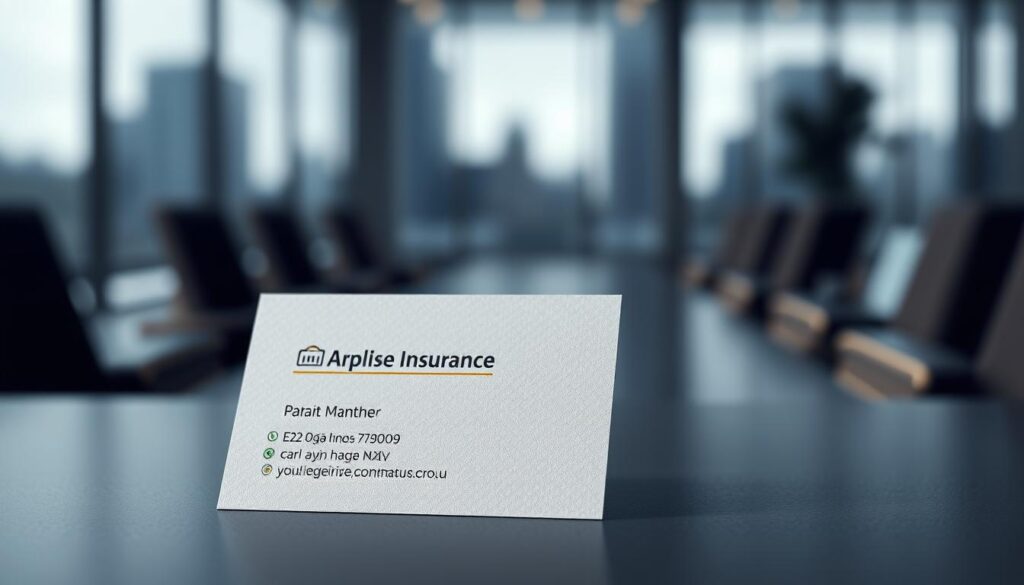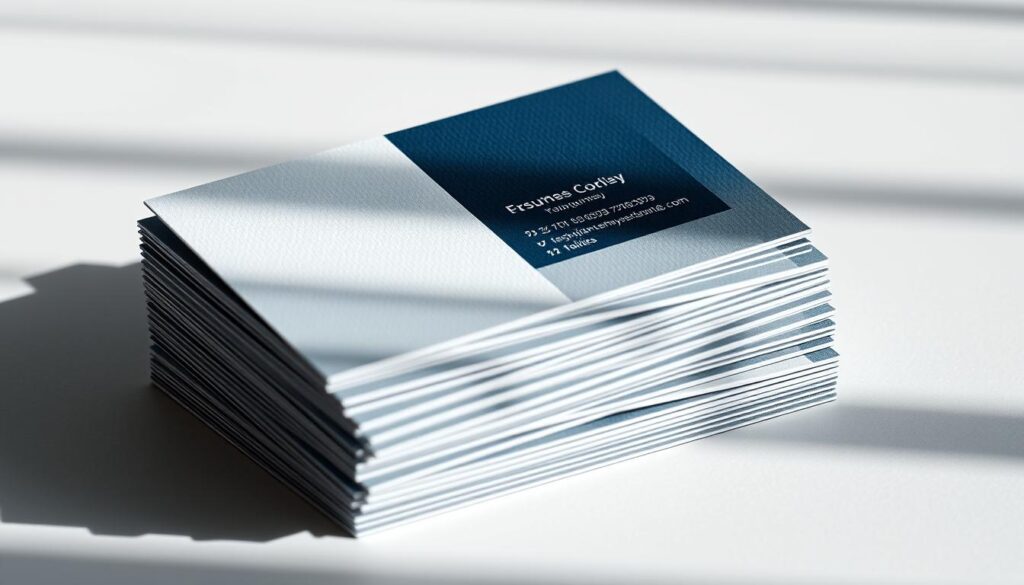In a competitive market, making a lasting impression is key for insurance pros. A well-designed, personalized insurance business card can make you unforgettable.
A customized business card design for insurance agents does more than share your contact info. It shows off your brand’s identity. It highlights your professionalism and attention to detail, making you stand out.
With a best insurance business card, you can share your unique value. It helps build trust with clients. It’s a vital tool for networking and growing your business.
Key Takeaways
- A personalized business card can elevate your professional image.
- Customized designs help you stand out in a competitive market.
- A well-designed card can convey your unique value proposition.
- It’s an essential tool for networking and building trust with clients.
- A professional business card reflects your attention to detail.
The Power of First Impressions in the Insurance Industry
The insurance industry is all about trust. A good first impression can start a strong client relationship. When agents meet clients during big life events, like buying a home or filing a claim, it’s key.
Why Business Cards Matter for Insurance Professionals
Business cards are essential for insurance agents. They show their brand and contact info. A great insurance agent business card can make an agent stand out. This makes it easier for people to remember them.
Companies like Farmers Insurance and State Farm use their cards to market. They put their branding and key messages on them.
| Insurance Company | Business Card Features | Marketing Impact |
|---|---|---|
| Farmers Insurance | Logo, Contact Info, Tagline | Brand Recognition |
| State Farm | Agent Name, Company Logo, Services | Client Trust |
| Allstate | Agent Photo, Contact Details, Specialties | Personal Connection |
The Psychology Behind Professional Presentation
How insurance agents present themselves matters a lot. A well-made insurance business card shows professionalism and care. This helps build trust with clients.
The psychology of presentation is clear. Clients prefer agents who look organized and skilled.
Essential Elements of Effective Insurance Business Cards
A business card is often the first point of contact between an insurance agent and a client. Its design and content are key. To make an effective insurance business card, several important elements must be considered.
Contact Information Must-Haves
Your insurance business card should have your name, title, phone number, email, and physical address. Clear and concise contact information is essential. It makes it easy for clients to reach out to you. You might also want to add your website or social media handles for more ways to connect.
Licensing and Credential Display
Showing your professional licenses and credentials on your card builds trust with clients. Include your license number and any relevant certifications, like “Licensed Insurance Agent” or “Certified Financial Planner.” In the insurance world, credibility and professionalism are very important.
Company Branding Requirements
Your business card should show your company’s brand through logos, colors, and fonts. Consistent branding strengthens your professional image and makes your card stand out. Make sure your card design fits with your company’s marketing strategy and visual identity.

Designing Your Insurance Business Card for Maximum Impact
Creating an effective insurance business card is key to making a strong impression. A good card shows your contact info and your professionalism. It also shares your brand’s identity.
Color Psychology for Insurance Professionals
The colors on your business card matter a lot. Blue is often seen as trustworthy and stable, which is why it’s popular for insurance pros. “Colors can evoke emotions and convey messages without words,” a design expert notes. Pick colors that match your brand’s personality and appeal to your audience.

Typography and Readability Considerations
Your business card’s typography should be clear and consistent with your brand. Stay away from fonts that are too fancy or hard to read. Choose simple, professional fonts that show reliability. For insurance cards, keep it simple.
Paper Stock and Finish Options
The paper and finish of your card also matter. High-quality paper makes your card feel premium. A matte finish reduces glare and makes text easier to read. Choose durable paper that fits your printing method.
By focusing on these design aspects, you can make a business card that looks professional and communicates your brand well. Whether you’re an independent agent or part of a big insurance company, a well-designed card is vital for your professional image.
Customization Options to Make Your Insurance Business Card Stand Out
Make your insurance business card special with customization. In a busy market, you need to stand out. This means being creative and personal.
Specialty Printing Techniques
Specialty printing can make your card unique. Spot varnishing and foil stamping add elegance. They highlight your name or logo, making your card look premium.
Unique Shapes and Sizes
Try a non-traditional shape for your card. Die-cutting into a unique shape or using a different size can be memorable. It’s great for medicare business cards or other special services.
QR Codes and Digital Integration
Add a QR code to your card. It links to your website, a video, or testimonials. This makes it easy for people to learn about your services.
| Customization Option | Description | Benefit |
|---|---|---|
| Specialty Printing | Techniques like spot varnishing and foil stamping | Enhances visual appeal and gives a premium feel |
| Unique Shapes and Sizes | Die-cutting into unique shapes or non-standard sizes | Makes your card memorable and stands out |
| QR Codes | Linking to professional websites or client testimonials | Provides a quick way for people to learn more |

Step-by-Step Guide to Creating Personalized Insurance Business Cards
Making a personalized insurance business card is key to showing who you are in the insurance world. It’s about following a few important steps. These steps make sure your card shows your brand well and shares important details with clients.
First, collect all the info you want on your card. This is the first step to making a card that’s both useful and looks professional.
Gathering Your Essential Information
Getting your essential info right is the base of a great insurance agent business card. You’ll need your contact details, professional titles, and any licenses. Make sure everything is correct and current to keep clients trusting you.
- Full name and title
- Contact information (phone number, email, and physical address)
- Professional credentials and licenses
- Company name and logo
Working with Designers vs. DIY Options
After you have your info ready, choose whether to hire a designer or do it yourself. A designer can give you a card that really shows off your brand. DIY options are quicker and cheaper, though.
Think about what each option offers:
- Designers can make your card unique and personal
- DIY is faster and easier on your wallet
Reviewing and Approving Your Design
Once your design is done, check it over carefully. Look for any mistakes, make sure all info is right, and see if it fits your brand.
Here’s what to check:
- Is your contact info and credentials correct?
- Is the design easy to read?
- Does it match your company’s style?
By following these steps, you can make a insurance company visiting card that shows off your professional side. It will help you shine in the tough insurance market.
Insurance Business Card Templates and Examples
Customized insurance business card templates let professionals shine in a crowded market. The right design helps agents share their brand and contact info.

Independent Insurance Agent Business Card Designs
Independent agents can show off their unique service with special business card designs. Templates with prominent display of professional certifications and a clean, modern layout build trust with clients.
Corporate Insurance Business Card Templates
Corporate agents need templates that show off their company’s brand and a formal design. These should include the company logo, agent title, and contact info clearly.
Specialty Insurance Business Card Examples
Specialty agents, like public adjusters, can use cards that highlight their expertise. Templates with bold colors and unique layouts showcase their specialized services.
Using these templates, insurance pros can make marketing tools that help them connect and grow.
Tailoring Business Cards for Different Insurance Specialties
Different insurance specialties need unique business card designs. This helps them show their value clearly. Insurance pros in various fields can use custom cards to showcase their special services and skills.
For insurance agents, a business card is more than a contact detail. It’s a way to show their professional brand. The design and content should match their target audience and highlight their services.
Health Insurance and Medicare Agent Business Cards
Health and Medicare agents can use cards that show they help with complex plans. Including keywords like “Medicare Advantage” or “Health Insurance Marketplace” can attract clients.
For instance, a health insurance agent might say “Expert Guidance on Medicare Plans” or “Your Partner in Navigating Health Insurance Options.” This shows their expertise.
Life Insurance Business Cards
Life insurance agents can focus on security, protection, and legacy. Phrases like “Securing Your Family’s Future” or “Protecting What Matters Most” are good choices.
Life insurance cards might also have a call to action. For example, “Get a Quote Today” or “Schedule a Consultation” to prompt action.
Auto, Home, and Property Insurance Business Cards
Agents for auto, home, and property insurance can highlight protecting clients’ assets. Cards might say “Protecting Your Home, Protecting Your Family” or “Auto Insurance Solutions for a Safer Drive.”
| Insurance Specialty | Key Themes | Example Phrases |
|---|---|---|
| Health & Medicare | Guidance, Healthcare Plans | “Expert Medicare Guidance”, “Navigating Health Insurance” |
| Life Insurance | Security, Protection, Legacy | “Securing Your Future”, “Protecting Your Family” |
| Auto, Home, Property | Asset Protection | “Protecting Your Home”, “Auto Insurance Solutions” |
By making their business cards specific to their insurance area, agents can better connect with their audience. This helps them stand out in a competitive market.
Digital Insurance Business Cards and Integration Strategies
In today’s digital world, insurance pros are using virtual business card platforms to boost their networking. The old-school business card is changing. Now, digital insurance business cards are key in the industry’s networking plans.
Virtual Business Card Platforms
Virtual business card platforms let insurance pros share their info and more easily. They make it simple to update your card without having to print new ones. Features like custom designs, QR codes, and analytics to see who’s interacting with your card are popular.
Combining Traditional and Digital Approaches
Using both digital and physical cards can be a strong strategy. You can hand out physical cards with a QR code that links to your digital card. This makes it easy to move between offline and online networking.
Measuring Business Card Effectiveness
To get the most out of digital insurance business cards, you need to track how well they’re doing. Look at scan rates, click-through rates, and conversion rates. This info helps you see what’s working and what needs tweaking.
| Metric | Description | Importance |
|---|---|---|
| Scan Rate | Percentage of people who scan the QR code | High |
| Click-Through Rate | Percentage of people who click on links after scanning | Medium |
| Conversion Rate | Percentage of people who take a desired action | High |
By using digital insurance business cards and integrating them into their plans, insurance pros can get more visibility. They can also improve client engagement and grow their business.
Effective Distribution and Usage Strategies for Insurance Business Cards
To make your insurance business card work for you, you need a smart plan for when and where to give them out. A great card won’t do much if it doesn’t reach the right people. So, it’s key to think carefully about when and where to share your cards.
Networking Event Best Practices
Networking events are a top chance to share your insurance business cards. Here are some tips to get the most out of these events:
- Keep your business cards ready to hand out during chats.
- Use these events to meet new people who might need your services.
- Reach out to new contacts after the event to keep in touch.
Client Meeting Protocols
When you meet with clients, it’s important to have a plan for handing out your business cards. Here’s what to do:
- Always carry enough business cards with you.
- Give out your card at the start or end of the meeting, based on the situation.
- Make your card more personal by writing a note on it.
Community Engagement Opportunities
Getting involved in your local community is a smart way to share your insurance business cards. It also helps you grow your professional network. Here are some ideas:
- Join local events, like charity functions or community fairs.
- Support local groups or teams to get your name out there.
- Volunteer for causes you care about to make connections.
By using these strategies, insurance pros can share their business cards wisely. This boosts their image and grows their network.
Conclusion: Leveraging Your Personalized Insurance Business Card for Long-Term Success
A well-designed insurance business card is more than just a piece of paper. It’s a powerful tool for insurance professionals to establish their brand. It helps build lasting relationships with clients. By investing in personalized insurance business cards, you can stand out in a competitive market.
Effective business card design for insurance agents combines essential contact information, professional credentials, and company branding. This creates a cohesive visual identity. Whether you’re an independent agent or part of a larger insurance company, a well-designed insurance agent business card can help you attract new clients.
Throughout this article, we’ve explored many options for creating a unique visiting card insurance agent that reflects your professional image. By using the strategies and design principles outlined here, you can create a business card. It will not only represent your brand but also drive long-term success in the insurance industry.
FAQ
What information should be included on an insurance business card?
Your insurance business card should have your name, phone number, email, and address. It’s also key to show your licenses and credentials. This builds trust. Don’t forget to add your company’s logo and tagline for recognition.
How can I make my insurance business card stand out?
To make your card pop, try special printing like spot varnishing or embossing. Use unique shapes or sizes. Adding a QR code that links to your website or social media is also a great idea.
What are the benefits of using a QR code on my insurance business card?
A QR code lets people quickly find your online presence. This makes it easy for them to contact you or learn more about your services.
Can I design my own insurance business card, or should I work with a designer?
You can design your own card with DIY templates. But, a professional designer can make sure it looks good and represents you well. They can help pick the right design and colors.
How often should I update my insurance business card?
Update your card when your contact info, licenses, or branding change. This keeps your card current and true to your professional image.
Are digital business cards a viable alternative to traditional insurance business cards?
Digital cards are a good option in today’s digital world. They’re easy to update and share. But, traditional cards are great for in-person networking.
What are some effective strategies for distributing insurance business cards?
Give out cards at networking events, client meetings, and community events. Always carry some with you for unexpected networking chances.
How can I measure the effectiveness of my insurance business card?
Track the leads from your card, monitor QR code responses, and ask for feedback. This helps you see how well your card is working.

